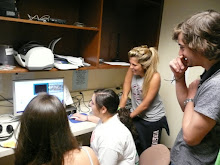This tutorial goes over making ALL your raw clips' audio into stereo BEFORE you start bringing them into the timeline. You will be selecting all of your clips in the project clip bin to do this.
This tutorial goes over making the audio of your INDIVIDUAL clips already in your timeline into STEREO. You'll want to make your dialogue into stereo so it's not just coming out of one speaker when you export it and then play it back. It will also not be loud enough if it remains in mono (one) track.
Panasonic Camcorder Tutorials:
 |
| Click the button for Panasonic tutorials |
Canon 60D DSLR Tutorial:
 |
| Click the button to access the DSLR tutorial |
Final Cut Editing Tutorials:
 |
| Click the button to access the editing tutorials |
This guy is sort of crude, but the explanations he gives are really good of f-stops, different shutter speeds, motion blur, ISO and "noise," and low key vs. high key lighting.
Nikon d3200 DSLR tutorial for shooting video
This will be useful right before you go out to shoot video with the CMP Department's DSLR cameras.
"Waterfall Video:" Frame Rate vs. Shutter Speed
Frame Rate vs Shutter Speed from Jake Primgaard on Vimeo. This is a really good visual demonstration of shutter speed and how motion blur is sometimes desirable because we are used to seeing fast objects blurred in film and television.
F-Stop explanation (short version)
Aperture, Shutter Speed, ISO Explained
This is a photography video, but the principles are relevant to video as well.
Using the Tripod
_________________________________
Another good Three Point Lighting explanation can be found here: http://www.graspr.com/videos/Izzy-Video-56-Behind-the-Scenes-of-Three-Point-Lighting
Aperture and Depth of Field Video:
"Trinity" Shallow Depth of Field video:
Shallow Depth of Field Practice: Todd Talks about Life
Here, I experimented with depth of field and my subject by placing him at different spots in relation to background and camera. Notice how the background sometimes seems blurry (especially starting at 2:05)--this is that desirable shallow depth of field we've been talking about in class. When he is close to the camera and far away from the flowering tree, there is good shallow depth of field on very zoomed-in settings. If I had placed the camera a bit further away (making the audio recording more challenging), while keeping him far away from the background, the effect would have been better because I wouldn't have had to zoom in as much.
Recording Audio "Down and Dirty" Guerilla-style
Microphone Differences:
Shot-Reverse-Shot:





















